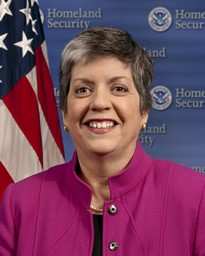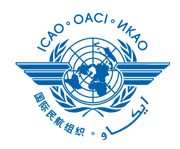Agency Now Vetting 100 Percent Of Passengers On Flights Within,
Or Bound For U.S. Against Watchlists
DHS Secretary Janet Napolitano announced Tuesday that 100
percent of passengers on flights within or bound for the United
States are now being checked against government watchlists -
fulfilling a key 9/11 Commission recommendation a month ahead of
schedule. TSA reached 100 percent watch list matching for all
domestic airlines on June 22.

Secretary Napolitano
Under Secure Flight, TSA prescreens passenger name, date of
birth and gender against terrorist watchlists before passengers
receive their boarding passes. In addition to facilitating secure
travel for all passengers, the program helps prevent the
misidentification of passengers who have names similar to
individuals on government watchlists. Prior to Secure Flight,
airlines held responsibility for checking passengers against
watchlists.
“Each and every one of the security measures we implement
serves an important goal: providing safe and efficient air travel
for the millions of people who rely on our aviation system every
day,” said Secretary Napolitano. “Secure Flight makes
air travel safer for everyone by screening every passenger against
the latest intelligence before a boarding pass is
issued.”
“The threats we face in the aviation sector are real and
evolving, and we must confront them with strong and dynamic
security measures,” said TSA Administrator John S. Pistole.
“Secure Flight bolsters our efforts to be more
intelligence-driven and risk-based in our approach to aviation
security. Our industry partners’ strong commitment to
security was critical to reaching the full implementation of this
vital counterterrorism program ahead of schedule.”

“We are pleased that DHS and TSA, with the cooperation of
ATA and its member airlines, were able to reach this important
security milestone ahead of schedule,” said Air Transport
Association President and CEO James C. May. “We look forward
to working with them and their security counterparts around the
world to continue to improve security while streamlining passenger
processing – a win-win for everyone.”
Passengers are required to provide their full name as it appears
on the government ID they plan to use when traveling, date of
birth, gender and, if applicable, Redress Number when booking their
airline reservations. TSA adheres to strict protocols to protect
individual privacy when conducting security checks.
Under Secure Flight, 99 percent of passengers are cleared to
print boarding passes at home or at a self-serve kiosk. Individuals
found to match watchlist parameters will be subject to secondary
screening, a law enforcement interview or prohibition from boarding
an aircraft, depending on the specific case. TSA deploys a
risk-based, layered security approach that utilizes a range of
measures, both seen and unseen, including advanced technology, law
enforcement, intelligence, terrorist watchlist checks and
international collaboration.

Since the attempted terrorist attack on December 25, 2009,
Secretary Napolitano, in conjunction with the International Civil
Aviation Organization (ICAO), has been leading a global initiative
to strengthen the international aviation system against the
evolving threats posed by terrorists, working in multilateral and
bilateral contexts with governments as well as industry. Over the
past year, Secretary Napolitano has participated in regional
aviation security summits around the world, forging historic
consensus with her international colleagues to strengthen the civil
aviation system through enhanced information analysis and sharing,
cooperation on technological development and modernized aviation
security standards.
These meetings culminated in the ICAO Triennial Assembly at the
beginning of October where the Assembly adopted a historic
Declaration on Aviation Security, which forges a historic new
foundation for aviation security that will better protect the
entire global aviation system from evolving terrorist threats.
 Aero-News: Quote of the Day (04.28.25)
Aero-News: Quote of the Day (04.28.25) ANN's Daily Aero-Term (04.28.25): Decision Altitude (DA)
ANN's Daily Aero-Term (04.28.25): Decision Altitude (DA) ANN's Daily Aero-Linx (04.28.25)
ANN's Daily Aero-Linx (04.28.25) Airborne-Flight Training 04.24.25: GA Refocused, Seminole/Epic, WestJet v TFWP
Airborne-Flight Training 04.24.25: GA Refocused, Seminole/Epic, WestJet v TFWP Aero-News: Quote of the Day (04.29.25)
Aero-News: Quote of the Day (04.29.25)





